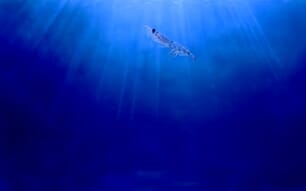Identity
Labeo rohita Hamilton, 1822 [Cyprinidae]
FAO Names: En - Roho labeo, Fr - Labéo Roho, Es - Labeo Roho
View SIDP Species fact sheet
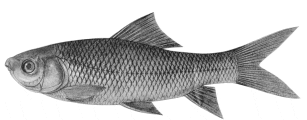
Biological features
Body bilaterally symmetrical, moderately elongate, its dorsal profile more arched than the ventral profile; body with cycloid scales, head without scale; snout fairly depressed, projecting beyond mouth, without lateral lobe; eyes dorsolateral in position, not visible from outside of head; mouth small and inferior; lips thick and fringed with a distinct inner fold to each lip, lobate or entire; a pair of small maxillary barbels concealed in lateral groove; no teeth on jaws; pharyngeal teeth in three rows; upper jaw not extending to front edge of eye; simple (unbranched) dorsal fin rays three or four, branched dorsal fin rays 12 to 14; dorsal fin inserted midway between snout tip and base of caudal fin; pectoral and pelvic fins laterally inserted; pectoral fin devoid of an osseous spine; caudal fin deeply forked; lower lip usually joined to isthmus by a narrow or broad bridge; pre-dorsal scale 12-16; lateral line distinct, complete and running along median line of the caudal peduncle; lateral line scales 40 to 44; lateral transverse scale-rows six or six and a half between lateral line and pelvic fin base; snout not truncate, without any lateral lobe; colour bluish on back, silvery on flanks and belly.
Profile
Historical background
Rohu (Labeo rohita) is the most important among the three Indian major carp species used in carp polyculture systems. This graceful Indo-Gangetic riverine species is the natural inhabitant of the riverine system of northern and central India, and the rivers of Pakistan, Bangladesh and Myanmar. In India, it has been transplanted into almost all riverine systems including the freshwaters of Andaman, where its population has successfully established. The species has also been introduced in many other countries, including Sri Lanka, the former USSR, Japan, China, the Philippines, Malaysia, Nepal and some countries of Africa. The traditional culture of this carp goes back hundreds of years in the small ponds of the eastern Indian states.
Information on its culture is available only from the early part of the 20th century. The compatibility of rohu with other carps like catla (Catla catla) and mrigal (Cirrhinus mrigala) made it an ideal candidate for carp polyculture systems. While riverine collection of seed was solely meeting the requirement for culture of the species until the first half of the 20th century, the success in induced breeding in 1957 and the assured seed supply thereafter was the major factor for the development of its culture in freshwater ponds and tanks. Its high growth potential, coupled with high consumer preference, have established rohu as the most important freshwater species cultured in India, Bangladesh and other adjacent countries in the region. Considering its importance in the culture system, emphasis has also been given to its genetic improvement through selective breeding in India.
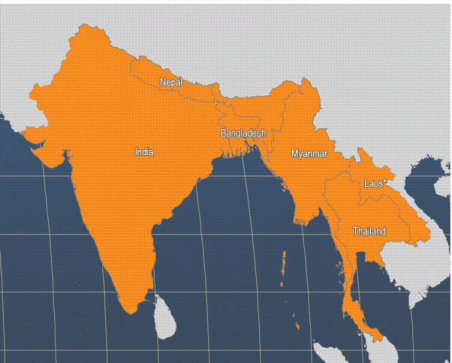
* the Lao People's Democratic Republic
Habitat and biology
In its early life stages rohu prefer zooplankton, mainly composed of rotifers and cladocerans, with phytoplankton forming the emergency food. In the fingerling stage, there is a strong positive selection for all the zooplanktonic organisms and for some smaller phytoplankters like desmids, phytoflagellates and algal spores. On the other hand, adults show a strong positive selection for most of the phytoplankton. In the juvenile and adult stages rohu is essentially an herbivorous column feeder, preferring algae and submerged vegetation. Furthermore, the occurrence of decayed organic matter and sand and mud in its gut suggests its bottom feeding habit. The nibbling type of mouth with soft fringed lips, sharp cutting edges and absence of teeth in the bucco-pharyngeal region helps the fish to feed on soft aquatic vegetation which do not require seizure and crushing. The modified thin and hair-like gill rakers also suggest that the fish feed on minute plankton through sieving water. In ponds, the fry and fingerlings exhibit schooling behaviour mainly for feeding; however, this habit is not observed in adults.
Rohu is a eurythermal species and does not thrive at temperatures below 14 °C. It is a fast growing species and attains about 35-45 cm total length and 700-800 g in one year under normal culture conditions. Generally, in polyculture, its growth rate is higher than that of mrigal but lower than catla.
The minimum age at first maturity for both sexes is two years, while complete maturity is reached after four years in males and five years in females. In nature, spawning occurs in the shallow and marginal areas of flooded rivers. The spawning season of rohu generally coincides with the south-west monsoon, extending from April to September. In captivity with proper feeding the species attains maturity towards the end of second year. However, breeding does not take place in such lentic pond environments; thus induced breeding becomes necessary. The fecundity varies from 226 000 to 2 794 000, depending upon fish size and ovary weight; on average it ranges from 200 000-300 000 eggs/kg BW. Rohu is a polygamous fish and also seems to be promiscuous. The optimum temperature for spawning is 22-31 °C.
Production
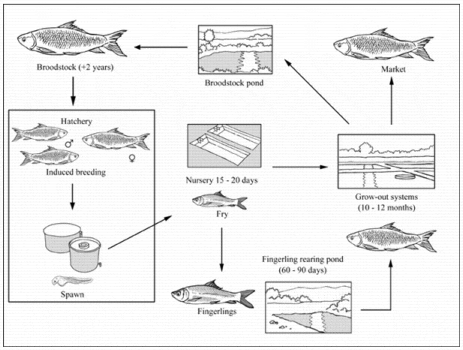
Production systems
Rohu is the principal species reared in carp polyculture systems along with the other two Indian major carps viz., catla, Catla catla and mrigal, Cirrhinus mrigala. Due to its wider feeding niche, which extends from column to bottom, rohu is usually stocked at relatively higher levels than the other two species. In India, the species is also cultured within composite carp culture systems incorporating all three Indian major carps, as well as common carp (Cyprinus carpio) and two Chinese carps viz., silver carp (Hypophthalmichthys molitrix) and grass carp (Ctenopharyngodon idellus). However, the percentage of rohu, even within this six-species combination, is retained at 35-40 per cent, similar to that in the three-species polyculture system. The higher consumer preference and market demand for rohu during recent years have also led to the practice of two-species culture with catla. The latter type of aquaculture is occurring in over 100 000 ha of ponds in the Koleru lake region of Andhra Pradesh, India, in which rohu forms more than 70 per cent of the stock.
The three Indian major carps, rohu being the most important, are also the dominant species cultured in other countries such as Bangladesh, Pakistan, Myanmar, Lao People's Democratic Republic, Viet Nam and Nepal. In all these countries, silver carp, grass carp and common carp are the most important species reared with the three Indian major carps in aquaculture.
Seed supply
Induced breeding of rohu has been catering for almost the entire seed requirement in all the countries where it is cultured, although riverine collection still forms the seed source in certain small areas. While induced breeding through hypophysation has been the common practice since the development of the technology in 1957, several synthetic commercial formulations of purified salmon gonadotropin and dopamine antagonists such as Ovaprim, Ovatide and Wova-FH have also been successfully used in recent years. When pituitary extract is used, females are injected with a stimulating dose of 2-3 mg/kg BW followed by a second dose of 5 to 8 mg/kg after a lapse of six hours; males are given a single dose of 2-3 mg/kg at the time of second injection of the female. When synthetic formulations are used, a single dose of 0.4-0.5 ml/kg body weight (females) or 0.2-0.3 ml/kg (males) is administered.
The Chinese circular hatchery is the most common system used for seed production. This type of hatchery possesses three principal components, viz., spawning/breeding tank, incubation/hatching tank, and water storage and supply system. The depth of water in the breeding tank is maintained at up to 1.5 m, based on the broodstock density; 3-5 kg broodstock/m³ is usually recommended. The female:male ratio is normally maintained at 1:1 by weight (1:2 by number). The size and number of hatching tanks vary, based on the production requirements and size of the breeding tank. The optimum egg density for incubation is 0.7-0.8 million/m³. In general, 0.15-0.2 million eggs/kg of female are obtained. The seed rearing normally involves a two-tier system, i.e. a 15-20 days nursery phase for raising fry, followed by a two-three months phase for fingerling production.
Rearing fingerlings
Nursery phase
Three day old hatchlings, measuring about 6 mm, are reared up to fry of 20-25 mm in small earthen nursery ponds of 0.02-0.1 ha. In certain areas, brick-lined or cement tanks are also used as nurseries. In many cases, although the stocking of a single species is normally advocated, farmers resort to stocking all three species of the Indian major carps. Pre-stocking nursery pond preparation should include the removal of aquatic weeds and predatory fish, followed by liming and fertilisation with organic manures and inorganic fertilisers. Aquatic insects are eradicated by the application of a soap-oil emulsion or removed by repeated netting before stocking. In earthen ponds, hatchlings are normally stocked at 3-10 million/ha, but higher levels of 10-20 million/ha are used in cement nurseries. The hatchlings normally receive a supplementary feed of a 1:1 w/w mixture of rice bran and groundnut/mustard oil cake. Survival ranges from 30 to 50 per cent. Though the beneficial effects of pre-stocking nursery pond preparation are well-established, some of these activities are often ignored by the farmers, resulting in poor fry survival. The non-availability of commercial feed, forcing the farmers to resort to the conventional bran-oilcake mixture, is another limiting factor for the growth and survival of fry.
Fingerling production
The nursery-raised fry of 20-25 mm are further reared for two-three months to 80-100 mm (6-10 g) fingerlings in earthen ponds of 0.05-0.2 ha. Here, rohu are grown together with other carp species at combined densities of 0.2-0.3 million fry/ha, with the rohu constituting about 30-40 per cent of the total. Pond fertilisation with both organic and inorganic fertilisers, and supplementary feeding with the conventional mixture of rice bran and oil cake are the norm; however, the dosage and form of application vary with the farming intensity and inherent pond productivity. The overall survival in these fingerling rearing systems ranges from 60 to 70 per cent.
Ongrowing techniques
The growout production of rohu, confined mainly to earthen ponds, is normally followed in combination with the other two Indian major carps within three-species polyculture systems, and in certain cases within a six-species composite carp culture system involving three Indian major carps, common carp, grass carp and silver carp in varied proportions, depending on their habitat preferences and feeding niches. While the adoption of scientific carp culture in recent years has been realising production levels of 3-5 tonnes/ha/yr, such practices are limited to only a few small areas. A large share of the production still comes from extensive farming involving stocking and fertilisation as the inputs and achieving more modest production levels of 1-2 tonnes/ha/yr. The practical technology includes predatory and weed fish control; stocking of fingerlings at a combined density of 4 000-10 000/ha (30-40 percent rohu); pond fertilisation with organic manures like cattle dung or poultry droppings and inorganic fertilisers; the provision of a mixture of rice bran/wheat bran and groundnut/mustard oil cake as supplementary feed, fish health monitoring and water management. The grow-out period is normally one year, during which rohu grows to about 700-800 g. In certain cases the farmers resort to partial harvesting of marketable size groups (>300 g) at intermittent intervals. In the Koleru lake area of Andhra Pradesh, the centre of commercial carp farming activity in India, the practice commonly involves the rearing of rohu and catla in two-species farming, with rohu constituting over 70 percent of the stock. In this case, stunted juveniles (i.e. fingerlings reared in crowded conditions for over one year, and 150-300 g in size) are used as the stocking material. The usual harvestable size of rohu is 1-1.5 kg and is achieved within a culture period of 12-18 months. Production levels of 6-8 tonnes/ha are recorded in such cases, with rohu contributing about 70-80 per cent of the biomass.
Although it is advocated that fingerlings (juveniles) are used for stocking grow-out ponds, their inadequate availability compels some farmers to stock their ponds with fry, leading to poor survival and production. Supplementary feed forms the major input, constituting over 50 per cent of the recurring expenditure in growout. The higher price of commercial feeds has been forcing farmers to resort to the conventional bran-oil cake mixture, usually supplied in dough form, thus leading to wastage and deterioration of water quality. Judicious feed management, therefore, requires attention in order to enhance the profit margin. In growout, especially at higher stocking densities an ectoparasite, carp lice (Argulus spp.), has been a major problem for rohu compared to other carps, causing reduction in growth and sometimes mortalities.
Rohu also forms one of the important components in the sewage-fed carp culture system practiced in an area totalling over 4 000 ha in West Bengal, India. In this form of culture, which includes multiple stocking and the multiple harvesting of fish larger than 300 g, primary treated sewage is provided to the fish ponds as the main input. Even without the provision of supplementary feed, this system produces 2-3 tonnes/ha/yr; with supplementary feeding, this can be increased to 4-5 tonnes/ha/yr.
Harvesting techniques
As carp are cultured in ponds and tanks that are usually quite small, manually operated dragnets are the most convenient gear used for harvesting. The length of these nets depends on the width of the pond. In most cases fish are harvested at the end of the culture period through repeated netting. However, in some cases, this is followed by total draining of the ponds. Cast nets are often used for partial harvesting in small and backyard ponds. In water bodies where multiple stocking and multiple harvesting are practised, the harvesting of larger sizes (300-500 g) is usually initiated after six-seven months of culture, and the smaller ones are returned to the pond for further growth. Multiple stocking and multiple harvesting is the most common practice in sewage-fed carp culture system.
Handling and processing
Rohu is the most preferred species among the cultivated Indian major carps. The marketing of this species mostly relies on local markets, where it is sold fresh. In large commercial farms where the harvest is considerable, fish, after washing thoroughly in water, are packed with crushed ice at 1:1 ratio in rectangular plastic crates (usually 60 cm x 40 cm x 23 cm in size). Long-distance transport of these ice-packed fish in insulated vans is a common practice in countries like India, where rohu are even transported over 3 000 km by road. Post-harvest processing and value-addition of this species is almost non-existent at present in any of the producing countries.
Production costs
In general, carp are low-valued species fetching market prices of less than USD 1/kg at the producers' level; therefore, the use of major inputs such as seed, fertilisers and supplementary feed, besides labour costs, is kept to a minimum. Supplementary feed constitutes over 50 per cent of the total input cost in carp polyculture; therefore, judicious feed management is of prime importance for enhancing profits. In extensive systems, with a targeted production level of 2-3 tonnes/ha, the cost of production is about USD 0.30/kg, while the costs increase to USD 0.5-0.6/kg in semi-intensive culture, where the targeted production is 4-8 tonnes/ha.
Diseases and control measures
| DISEASE | AGENT | TYPE | SYNDROME | MEASURES |
|---|---|---|---|---|
| Ulcer | Aeromonas spp., Pseudomonas spp. | Bacteria | Ulcerations; exophthalmia; abdominal distension | Destroy badly infected fish; disinfect ponds with 0.5 ppm solution of KMnO4; feed medicated feed [sulphadiazine in feed (100 mg/kg) or terramycin (75-80 mg/kg)] for 10-12 days |
| Columnaris | Flavobacterium columnaris | Bacterium | Raised white plaques, often with reddish peripheral zone leading to haemorrhagic spots on body | Dip treatment with 500 ppm KMnO4 |
| Dropsy | Aeromonas spp. | Bacteria | Body scales stretch out resembling pine cone; inflammation; ulceration; exophthalmia; abdominal distension | Disinfect pond with 1 ppm KMnO4; dip treatment of 5 ppm KMnO4 for 2 minutes |
| Saprolegniasis | Saprolegnia parasitica | Fungus | Mould grows like cotton wool on body, penetrating into muscle tissue; morbid muscle rot | 3-4 per cent NaCl bath; KMnO4 (160 mg/litre) bath for five days; malachite green (1-2 mg/litre) bath for 30 minutes to 1 hour; 20 ml/litre formalin in ponds |
| Branchiomycosis (gill rot) | Branchiomyces demigrans | Fungus | Fungus grows out through gill blood vessels and causes necrosis of surrounding tissues; yellow-brown discolouration & disintegration of gill tissues | Addition of quick lime (50-100 kg/ha) to affected ponds; in case of limited infections, use 3-5 per cent NaCl bath for 5-10 minutes, or 5 ppm KMnO4 solution bath for 5-10 minutes |
| Ichthyophthiriasis | Ichthyophtirius multifilis | Parasitic (protozoa) | Skin, fin rays & operculum are covered with white spores; sick fish keeps rubbing against hard substratum | Dip treatment for 1 hour per day in 1:5000 formalin for 7-10 days solution or in 2 per cent NaCl for 7 to 10 days; disinfect affected ponds with quicklime |
| Trichodiniasis | Trichodina reticulata; T. negre | Parasitic (protozoa) | Invasion of skin & gill regions of juveniles | 2-3 per cent NaCl bath for 5-10 minutes; 4 ppm KMnO4 bath for 5-10 minutes; 25 ppm formalin in pond treatment |
| White gill spot disease | Myxobolus bengalensis: M. hosadurgensis | Parasitic (protozoa) | Weakness; emaciation; raising of scales along their posterior margins; loss of scales; perforation of scales; loss of chromatophores | Reduce pond population; add yeast (1 g/kg) to feed; 2-3 per cent NaCl bath for 5-10 minutes |
| Dactylogyrosis & Gyrodactylosis | Dactylogyrus spp.; Gyrodactylus spp. | Parasites (monogenean trematodes) | Gill, fin & skin are affected; enhanced mucus secretion | 3-5 per cent NaCl dip treatment or 100 ppm formalin bath for 5-10 min; pond treatment with 25 ppm formalin or 4 ppm KMnO4 |
| Black spot or Diplostomiasis | Diplostomum pigmentata | Parasitic (digenetic trematodes) | Gill, fin & skin are affected; enhanced mucus secretion | 3-5 per cent NaCl dip treatment or 100 ppm formalin bath for 5-10 min; pond treatment with 25 ppm formalin or 4 ppm KMnO4 |
| Argulosis | Argulus spp. | Parasite (crustacean) | Parasites seen in naked eye attached to the head & fin ray of the fish | Ponds showing severe Argulus infection should be drained & dried; short duration dip in 5 ppm KMnO4; treatment with 'Butox' (35 ml/ha-m) at weekly intervals three times |
| Epizootic Ulcerative Syndrome | Aeromonas hydrophila; A. sorbia; Aphanomyces invadans | Bacterial & fungal | Large red or grey shallow ulcers with necrotic areas on skin; fungus covered deeper into the musculature; lesion of acute dermatitis & ulcer | Use of lime at 200 kg/ha; CIFAX (a CIFA, India formulation) at 0.1 ppm; maintenance of pond sanitation |
Suppliers of pathology expertise
The following are examples of locations where expertise can be accessed:
- Central Institute of Freshwater Aquaculture, India.
- Central Institute of Fisheries Education, Mumbai, India.
- College of Fisheries, Mangalore, India.
Statistics
Production statistics
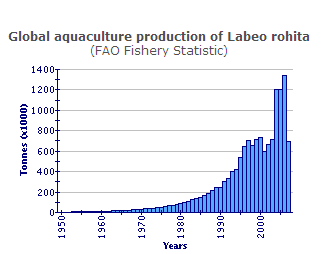
India is by far the largest producer of rohu but Bangladesh and, to a lesser extent, Myanmar are also major producers. Relatively low level production is also reported by Lao People's Democratic Republic and Thailand.
Market and trade
Almost all the rohu produced from aquaculture is consumed in local markets. Post-harvest processing is almost non-existent. Rohu is a highly preferred carp and fetches comparatively high market prices. In most areas, they are either marketed fresh in the local market or carried to nearby urban markets with ice. Rohu and catla fetch almost similar market prices, which are usually 10-20 percent higher than that for mrigal. Long-distance transport of the species in insulated vans with ice, covering distances of 2 000-3 000 km is common practice in India. However, locally-produced fresh fish fetches about one and half times higher market price than iced fish. Furthermore, when sold live, the market value increases over two-fold compared to iced fish. Governmental regulation and control over the domestic marketing system for these aquaculture products are almost non-existent; thus the market price is influenced mainly by demand and supply.
Status and trends
Several factors have enhanced the status of the farming of the Indian major carps:
- Improvements in induced breeding and seed production, which have removed the reliance on the capture of natural riverine seed.
- Improved growout technology.
- Improvements in feeding and health management.
On the other hand, while the inter-generic hybridisation of mrigal, rohu, catla, grass carp and common carp has been attempted, the hybrids did not show any genetic advantage over the parent stocks.
Other factors have caused problems. The adoption of intensive farming practices, unregulated use of inputs and lack of scientific know-how among the farmers has led to increased disease incidence. However, continued thrust on health management leading to development of therapeutics has helped the sector to overcome from such situations.
India has already drawn up a strategic plan for doubling freshwater aquaculture production through increases in productivity and area. Since rohu forms an important component of the carp polyculture system, it can be expected that there will be a two-fold increase in its production in India by 2015. Bangladesh is also expected to enhance farmed rohu production. The high growth potential of the Indian major carps has attracted the attention of several tropical South-Eastern Asian and Middle-Eastern countries.
Other factors are expected to influence further growth in the farming of Indian major carps, including:
- Selective breeding.
- Organic fish farming.
- Export to South-East Asian and Middle-East countries.
- Development of processing and value-added products.
The official production figures often do not represent a true picture, due to the lack of appropriate and uniform data collection mechanisms. The inadequate production statistical database has been an important drawback for the formulation of strategic development plans. The available information from several countries represents the total carp production, rather than that of individual species. Thus, uniform guidelines for database development would, to a great extent, help in the assessment of actual production and in the development of plans for the future.
Main issues
Carp are generally cultured in a closed system that involves herbivorous species, in which organic materials are used as the principal input sources, thereby making it a generally environment-friendly practice. Furthermore, the compatibility of rohu in polyculture systems with regard to habitat preference and feeding habits is good. However, the tendency of farmers to increase income per unit area has led to an excessive use of fertilisers, proteinaceous feeds and chemicals that may have detrimental effects on the environment. The compatibility of rohu in polyculture systems with other carps has already been established. Rohu, being a column feeder, grows well in deeper ponds (2-3 m water depth), which are rather uncommon; in shallower ponds it does not attain its optimum growth potential. Greater susceptibility of the species to Argulus infection over catla and mrigal in polyculture systems is another common problem, especially at higher stocking densities.
Responsible aquaculture practices
Being a low input-based system, carp culture has not generally been perceived as a threat to the environment. However, increased emphasis on intensification for enhancing production in recent years has resulted in increased use of chemical fertilisers, feeds, therapeutics, drugs, chemicals, etc., which pose some concern. It is therefore necessary that the practicing countries should formulate guidelines and impose strict regulatory measures for the judicious use of these critical inputs. Application of the principles of Article 9 of the FAO Code of Conduct for Responsible Fisheries would be appropriate.
March 2010



